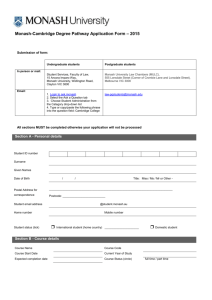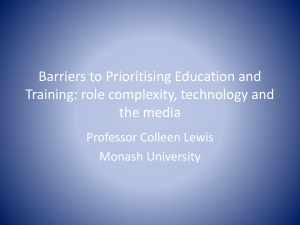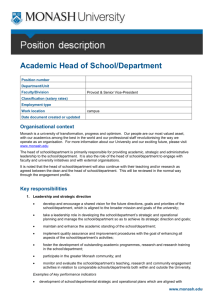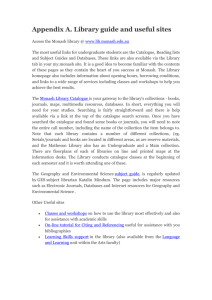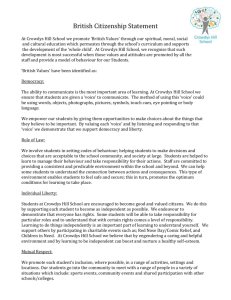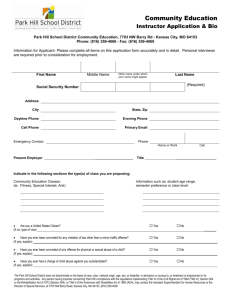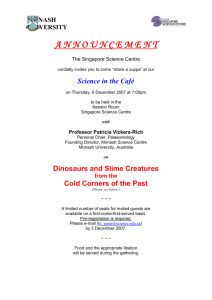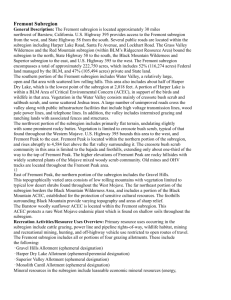Eastern Subregion Fact Sheet (DOC - 53KB)
advertisement
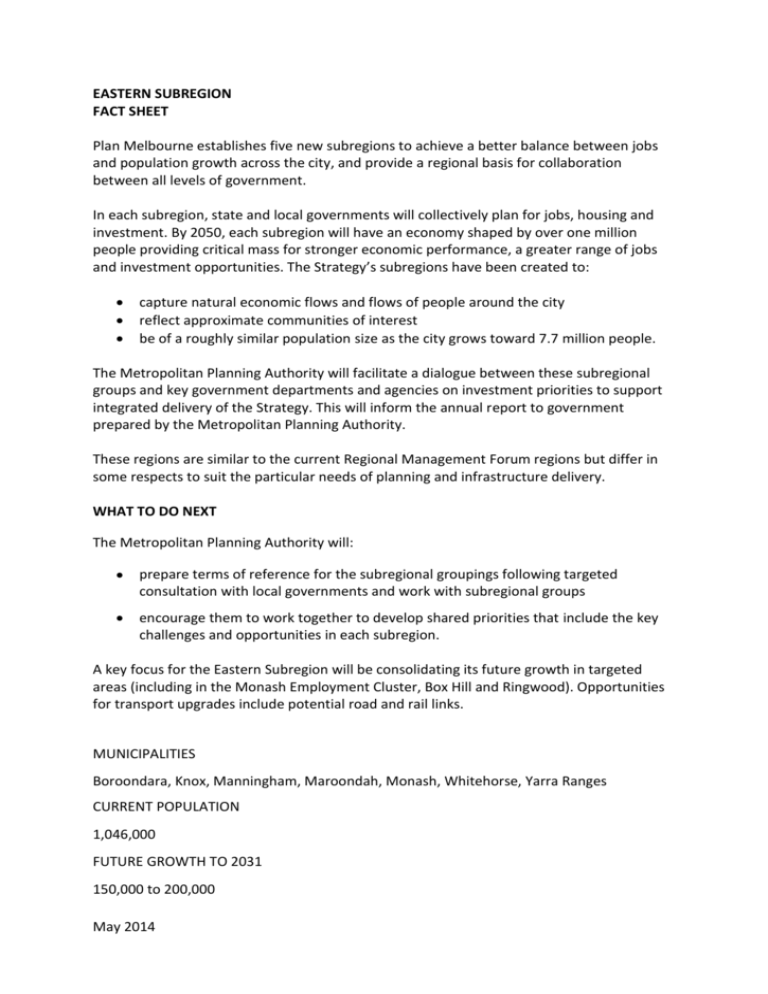
EASTERN SUBREGION FACT SHEET Plan Melbourne establishes five new subregions to achieve a better balance between jobs and population growth across the city, and provide a regional basis for collaboration between all levels of government. In each subregion, state and local governments will collectively plan for jobs, housing and investment. By 2050, each subregion will have an economy shaped by over one million people providing critical mass for stronger economic performance, a greater range of jobs and investment opportunities. The Strategy’s subregions have been created to: capture natural economic flows and flows of people around the city reflect approximate communities of interest be of a roughly similar population size as the city grows toward 7.7 million people. The Metropolitan Planning Authority will facilitate a dialogue between these subregional groups and key government departments and agencies on investment priorities to support integrated delivery of the Strategy. This will inform the annual report to government prepared by the Metropolitan Planning Authority. These regions are similar to the current Regional Management Forum regions but differ in some respects to suit the particular needs of planning and infrastructure delivery. WHAT TO DO NEXT The Metropolitan Planning Authority will: prepare terms of reference for the subregional groupings following targeted consultation with local governments and work with subregional groups encourage them to work together to develop shared priorities that include the key challenges and opportunities in each subregion. A key focus for the Eastern Subregion will be consolidating its future growth in targeted areas (including in the Monash Employment Cluster, Box Hill and Ringwood). Opportunities for transport upgrades include potential road and rail links. MUNICIPALITIES Boroondara, Knox, Manningham, Maroondah, Monash, Whitehorse, Yarra Ranges CURRENT POPULATION 1,046,000 FUTURE GROWTH TO 2031 150,000 to 200,000 May 2014 CURRENT NUMBER OF JOBS 366,400 FUTURE JOB GROWTH TO 2031 75,000 to 100,000 PLACES OF STATE-SIGNIFICANCE National employment cluster – Monash Metropolitan activity centres – Box Hill, Ringwood State-significant industrial precinct – Monash Health and / or education precincts – Box Hill Hospital, Monash Medical Centre (Clayton), Deakin University (Burwood), Swinburne University (Hawthorn), Monash University (Clayton), Knox Private Hospital PLACES OF LOCAL-SIGNIFICANCE Activity centres – Bayswater, Boronia, Brandon Park, Burwood East-Tally Ho, Burwood Heights, Camberwell Junction, Chirnside Park, Clayton, Croydon, Doncaster East-The Pines, Doncaster Hill, Forest Hill Chase, Glen Waverley, Hawthorn-Glenferrie Road, Kew Junction, Lilydale, Mount Waverley, Mountain Gate, Nunawading, Oakleigh, Rowville-Stud Park, Wantirna South-Knox Central Neighbourhood centres URBAN RENEWAL OPPORTUNITIES Ringwood station, Huntingdale to Dandenong station corridor, Glen Waverley Station, Lilydale Quarry, Nunawading station, Hughesdale IMPORTANT FUTURE INITIATIVES East West Link Stage One Cranbourne-Pakenham Rail Corridor Project Potential North-East Link Potential Rowville Rail Link Potential Doncaster Rail Link Note: All projects requiring budget funding will be carefully assessed (in relation to budget capacity). EASTERN SUBREGION SOURCE: DEPARTMENT OF TRANSPORT, PLANNING AND LOCAL INFRASTRUCTURE, 2014 MAP 33, PAGE 180 FROM THE PLANMELBOURNE BOOK is inserted here and it shows – Eastern Subregion May 2014 HOUSING REQUIREMENTS – BY TYPE TO 2031 SOURCE: DEPARTMENT OF TRANSPORT, PLANNING AND LOCAL INFRASTRUCTURE, 2014 Figure on PAGE 181 FROM THE PLAN MELBOURNE BOOK is inserted here and it illustrates the following: Housing Requirements – by Type to 2031 Total Dwelling Change 80,000 to 110,000 Detached Dwellings 15,000 to 25,000 Other Dwellings 70,000 to 90,000 Apartments 30,000 to 40,000 Townhouses/Units etc 40,000 to 60,000 SPATIAL ESTIMATES – BY AREA TO 2031 SOURCE: DEPARTMENT OF TRANSPORT, PLANNING AND LOCAL INFRASTRUCTURE, 2014 Figure on PAGE 181 FROM THE PLAN MELBOURNE BOOK is inserted here and it illustrates the following: Spatial Estimates – by Area to 2031 Total Dwelling Change 80,000 to 110,000 NATIONAL EMPLOYMENT CLUSTER MONASH EMPLOYMENT CLUSTER – which includes Monash University, CSIRO, the Australian Synchrotron, Monash Medical Centre and hospitals as well as other research-based activities and advanced manufacturing enterprises. The cluster has strengths in leading education, health, research and commercialisation facilities. It has about 58,500 jobs. METROPOLITAN ACTIVITY CENTRES BOX HILL Subregion: Eastern Local government area: Whitehorse Census employment count: 15,600 Top three industries • Health care and social assistance • Public administration and safety • Education and training Dwellings*: 4,400 Number of visits**: 36,829 Key features: Box Hill Institute, Box Hill Hospital and Epworth Hospital, Centro Box Hill Shopping Centre, Box Hill Town Hall Transport: Train, tram and bus May 2014 RINGWOOD Subregion: Eastern Local government area: Maroondah Census employment count: 6,700 Top three industries • Retail trade • Public administration and safety • Health care and social assistance Dwellings*: 4,800 Number of visits**: 37,775 Key features: Eastland Shopping Centre, Costco, Ringwood Magistrates’ Court Transport: Train, bus and arterial road Number of dwellings in and around the metropolitan activity centre ** Victorian Integrated Survey of Travel and Activity (VISTA) FIND OUT MORE View our website: www.planmelbourne.vic.gov.au Email us on: planmelbourne@dtpli.vic.gov.au Victorian Government Contact Centre 1300 366 356 Translation Service 131 450 Data disclaimer Unless indicated otherwise, this work is made available under the terms of the Creative Commons Attribution 3.0 Australia licence. To view a copy of this licence, visit hyyp://creativecommons.org/licenses/by/3.0/au. It is a condition of this Creative Commons Attribution 3.0 Licence that you must give credit to the original author who is the State of Victoria. Authorised and published by the Victorian Government, 1 Treasury Place, Melbourne Victoria 3000 April 2014. The State of Victoria does not warrant the accuracy or completeness of information in this publication and any person using or relying upon such information does so on the basis that the State of Victoria shall bare no responsibility or liability whatsoever for any errors, faults, defects or omissions in the information. May 2014
